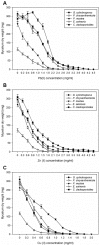The response of dark septate endophytes (DSE) to heavy metals in pure culture
- PMID: 23118914
- PMCID: PMC3485351
- DOI: 10.1371/journal.pone.0047968
The response of dark septate endophytes (DSE) to heavy metals in pure culture
Abstract
Dark septate endophytes (DSE) occur widely in association with plants exposed to heavy metal stress. However, little is known about the response of DSE exposed to heavy metals. In this study, five DSE were isolated from the roots of Astragalus adsurgens Pall. seedlings growing on lead-zinc mine tailings in China. Based on morphological characteristics and DNA sequence analyses, the isolates were identified as Gaeumannomyces cylindrosporus, Paraphoma chrysanthemicola, Phialophora mustea, Exophiala salmonis, and Cladosporium cladosporioides. G. cylindrosporus was selected to explore responses to Pb stress. Scanning electron microscopic observations of G. cylindrosporus grown on solid medium revealed curling of hyphae and formation of hyphal coils in response to Pb. In contrast, in liquid medium, hyphae became thick and swollen with an increase in Pb (II) concentration. We interpret that these changes are related to the variation in cell wall components. We also demonstrated that fungal melanin content increased with the addition of Pb(II). Melanin, as an important component in the cell wall, is known to be an essential antioxidant responsible for decreasing heavy metal toxicity. We also measured the total soluble protein content and glutathione (GSH) concentrations in G. cylindrosporus and found that they initially increased and then decreased with the increase of Pb(II) concentrations. The antioxidant enzyme activities were also examined, and the results showed that superoxide dismutase (SOD) activity was significantly positively correlated with Pb(II) concentrations (r = 0.957, P<0.001). Collectively, our observations indicate that the intracellular antioxidant systems, especially fungal melanin, play an important role in abating the hazards of heavy metals.
Conflict of interest statement
Figures









References
-
- Ruttens A, Mench M, Colpaert JV, Boisson J, Carleer R, et al. (2006) Phytostabilization of a metal contaminated sandy soil. I: Influence of compost and/or inorganic metal immobilizing soil amendments on phytotoxicity and plant availability of metals. Environ Pollut 144: 524–532. - PubMed
-
- Granero S, Domingo JL (2002) Levels of metals in soils of Alcalá de Henares, Spain: Human health risks. Environ Int 28: 159–164. - PubMed
-
- Selosse M-A, Baudoin E, Vandenkoornhuyse P (2004) Symbiotic microorganisms, a key for ecological success and protection of plants. C R Biol 327: 639–648. - PubMed
-
- Gadd GM (2007) Geomycology: biogeochemical transformations of rocks, minerals, metals and radionuclides by fungi, bioweathering and bioremediation. Mycol Res 111: 3–49. - PubMed
-
- Valix M, Tang JY, Malik R (2001) Heavy metal tolerance of fungi. Miner Eng 14: 499–505.
Publication types
MeSH terms
Substances
Associated data
- Actions
- Actions
- Actions
- Actions
- Actions
LinkOut - more resources
Full Text Sources
Molecular Biology Databases

